 Advances in Psychology 心理学进展, 2013, 3, 175-184 http://dx.doi.org/10.12677/ap.2013.34028 Published Online July 2013 (http://www.hanspub.org/journal/ap.html) Autobiographical Memory System and Its Neural Correlates* Lu Yin, Lihua Mao#, Shengchuang Feng, Xiang Ye, Yucai Shi Department of Psychology, Peking Universi t y , B e ij i ng Email: yinl06@126.com, #maolihua@pku.edu.cn Received: Apr . 14th, 2013; revised: May 8th, 2013; accepted: May 27th, 2013 Copyright © 2013 Lu Yin et al. This is an open access article distributed under the Creative Commons Attribution License, which per- mits unrestricted use , distribution, and reproduction in any medium, provided the original work is properly cited. Abstract: Autobiographical memory, with special inherent structure, is a complex component of long-term memory. It has a close relationship with semantic memory and episodic memory and is also connected with many other psychological cognitive processes, such as the emotional process, self-referential process etc. Accordingly, the neural correlates of autobiographical memory consist of many brain areas, including the frontal lobe, temporal lobe, superior parietal lobe and the adjacent occipital area etc. All of the brain areas mentioned above are mainly on the left hemisphere. This article summarizes the previous researches on autobiographical memory and its neural correlates. Given the complexity of autobiographical memory, we divide different cognitive processes of autobiographical memory into 5 operating components from the perspective of memory-system. These operating components include semantic component, episodic com- ponent, self-referential component, emotional component and general cognitive processing component (cognitive process related to general memory retrieval), and each component has its underlying neural correlates. What is more important, these operating components interact with each other coherently within the au tobiograp hical me mory sys tem and this article d iscusses these inte raction s and connec tions in d epth. These interactions analyzed in this article includes the semantic & episodic interaction, the self-referential processing & general cognitive processing interaction, the emotional & episodic interaction, the general cognitive processing & episodic interaction and the general cognitive processing & emotional interaction. By taking the interactions among the operating components into con sid er ati on , di fferent i de as an d op in ions to integrate the experiment findings are offered, and new ways and solutions to settle some heating debates in the field of autobiographical memory are proposed. Furthermore, this article points out that even though the operating components o f autobiographical memo ry system are closely connected wi th one another, the previous researches didn’t pay enough attention to it. This article analyzes two problems existing in the previous studies. First, most of the previous researches spent much effort in analyzing the different acti- vated brain areas among different experiment tasks, while leaving the common brain activation alone, which might reflect the interaction and connection among the operating components. Second, those studies investigating neural correlates of autobiographical memory using brain imaging techniques tended to overlook the different brain activations at different time points, and these temporal differences may carry important information about the neural mechanism of autobiographical memory. Finally, the article pro- poses two analytical methods in order to solve the problems mentioned above to some extent. First is using multi-voxel analysis instead of the conventional analysis method to reveal the useful information held by the common activated brain areas, second is employing time series analysis to analyze the changes of brain activation pattern in the temporal dimension. In sum, if researchers are going to investigate the neural mechanism of autobiographical memory thoroughly and offered more convincing evidence, they should treat the various cognitive processes of autobiographical memory as a whole, take the interactions among different components into consideration and pay more attention to the neural correlates underlying these interactions. Keywords: Autobiographical Memory; Memory System; Operating Component; Interaction; Multi-Voxel Analysis; T im e Series Analysis *国家自然科学基金面上项目《不同社会角色个体自我与亲密他人参照加工神经机制的研究》(31070897)资助。 #通讯作者。 Copyright © 2013 Hanspub 175  自传体记忆系统及其神经机制 Copyright © 2013 Hanspub 176 自传体记忆系统及其神经机制* 尹 璐,毛利华#,冯胜闯,叶 香,史煜才 北京大学心理学系,北京 Email: yinl06@126.com, #maolihua@pku.edu.cn 收稿日期:2013 年4月14 日;修回日期:2013 年5月8日;录用日期:2013年5月27日 摘 要:自传体记忆作为一个复杂的,涉及众多因素的长时记忆成分,具有独特的记忆结构;相应地, 自传体记忆的神经机制也包括了众多脑区。基于自传体记忆的复杂性,本文总结了先前对于自传体记 忆及其神经机制的研究,从记忆系统的角度对自传体记忆包含的认知加工成分及相应的神经机制进行 了归纳总结,并就各认知加工成分间的相互联系和相互作用进行了详尽的分析;同时分析了目前自传 体记忆神经机制研究存在的一些局限性,包括偏重强调实验条件间差异性而对不同认知加工成分脑机 制间的相互联系分析不足,只关注脑区激活的空间定位而忽视时间维度的差异信息等。最后本文提出 在将来的研究中需要更多地从系统的观点出发,重视认知加工成分间的相互联系,引入多体素分析和 时间序列分析以便能为自传体记忆神经机制研究提供更深入的证据。 关键词:自传体记忆;记忆系统;操作成分;相互作用;多体素分析;时间序列分析 1. 前言 自传体记忆并没有严格统一的定义。一般认为, 自传体记忆是建立在情景记忆和语义记忆基础之上 的一个长时记忆成分,在自传体记忆中存储的主要是 个体经历的生活事件(Cohen & Conway, 2008)。对于自 传体记忆的研究可以追溯到 Galton 的早餐问卷及 Freud 的自由联想(张志杰,黄希庭,2003),然而直到 Tulving(1972)将情景记忆作为一个独特的记忆成分从 长时记忆中划分出来,研究者们才真正开始将自传体 记忆作为一个研究对象进行系统研究,但此时研究者 们并没有对自传体记忆和情景记忆进行严格的区分。 随着研究的深入,研究者们逐步提出了自传体记忆的 相关理论模型,将自传体记忆看做是一个不同于情景 记忆的结构化的长时记忆成分(Conway, 2001; Con- way & Pleydell-Pearce, 2000)。 自传体记忆的研究方法主要包括日记法和记忆 搜索法(语词回忆法)。日记法要求被试在特定的时期 内对每天发生的值得记忆的事件进行记录,实验者会 从这些记录中抽取一部分条目,同时混入一定干扰条 目要求被试进行再认,借以对自传体记忆的保持进行 研究(Conway, Collins, Gathercole, & Ande rson, 1996); 而记忆搜索法则是通过向被试呈现一系列的词语来 诱发被试的自传体记忆提取(Rubin & Schulkind, 1997)。记忆搜索法在引入比较条件的基础上被用于自 传体记忆脑成像研究。被引入的比较条件一般是语义 记忆提取条件或情景记忆提取条件,这些比较条件也 采用记忆搜索法进行记忆提取,只不过在比较条件下 提取的不是自传体记忆而是语义或者情景记忆 (McDermott, Szpunar, & Christ, 2009)。 较之于其他长时记忆成分,自传体记忆具有特殊 的记忆结构(Conway & Pleydell-Pearce, 2000),且与其 他记忆成分有着密不可分的联系(Conway, Singer, & Tagini, 2004; Gilboa, 2004);此外自传体记忆还具有自 我参照的性质(Conway, 2005; Sajo nz et al., 2010),并与 情绪过程之间存在相互作用(Berntsen & Rubin, 2002; Christianson & Safer, 1996; Holland & Kensinger, 2010; 王凤,冯正直,2009)。上述特征使自传体记忆成为了 一个涉及到众多认知加工过程(如自我参照过程,情绪 过程等)的复杂的长时记忆成分。关于自传体记忆脑成 像的研究也表明自传体记忆背后的神经机制是一个 广泛分布在大脑各个区域的神经网络,这个神经网络 包括额叶、颞叶、顶叶等相关脑区(Cabeza & St Jacques, 2007; Conway, Pleydell-Pearce, Whitecross, & Sharpe, 2002; Maguire, 2001; Svoboda, McKinnon, & Levine, 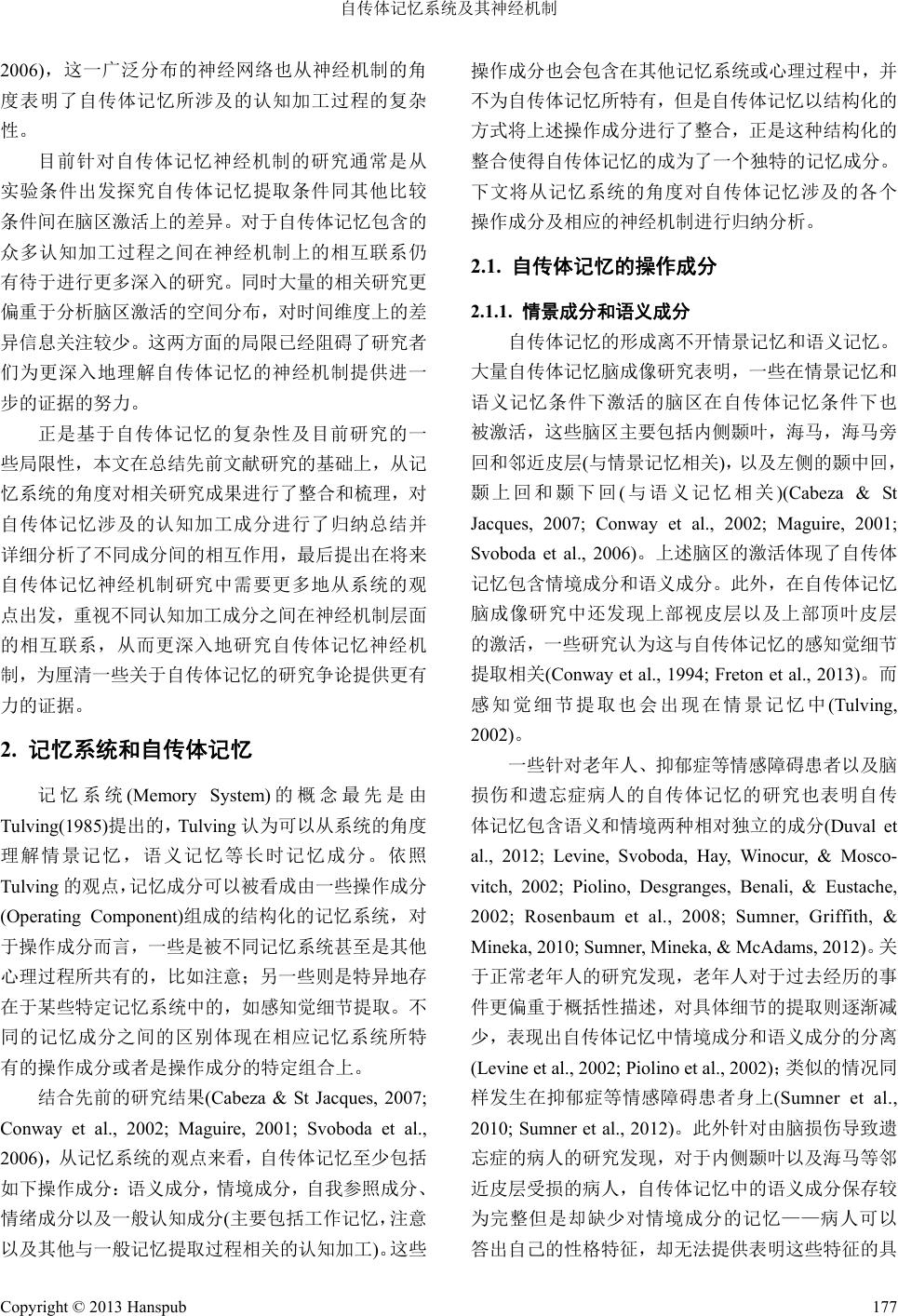 自传体记忆系统及其神经机制 2006),这一广泛分布的神经网络也从神经机制的角 度表明了自传体记忆所涉及的认知加工过程的复杂 性。 目前针对自传体记忆神经机制的研究通常是从 实验条件出发探究自传体记忆提取条件同其他比较 条件间在脑区激活上的差异。对于自传体记忆包含的 众多认知加工过程之间在神经机制上的相互联系仍 有待于进行更多深入的研究。同时大量的相关研究更 偏重于分析脑区激活的空间分布,对时间维度上的差 异信息关注较少。这两方面的局限已经阻碍了研究者 们为更深入地理解自传体记忆的神经机制提供进一 步的证据的努力。 正是基于自传体记忆的复杂性及目前研究的一 些局限性,本文在总结先前文献研究的基础上,从记 忆系统的角度对相关研究成果进行了整合和梳理,对 自传体记忆涉及的认知加工成分进行了归纳总结并 详细分析了不同成分间的相互作用,最后提出在将来 自传体记忆神经机制研究中需要更多地从系统的观 点出发,重视不同认知加工成分之间在神经机制层面 的相互联系,从而更深入地研究自传体记忆神经机 制,为厘清一些关于自传体记忆的研究争论提供更有 力的证据。 2. 记忆系统和自传体记忆 记忆系统(Memory System)的概念最先是由 Tulving(1985)提出的,Tulving 认为可以从系统的角度 理解情景记忆,语义记忆等长时记忆成分。依照 Tulving 的观点,记忆成分可以被看成由一些操作成分 (Operating Component)组成的结构化的记忆系统,对 于操作成分而言,一些是被不同记忆系统甚至是其他 心理过程所共有的,比如注意;另一些则是特异地存 在于某些特定记忆系统中的,如感知觉细节提取。不 同的记忆成分之间的区别体现在相应记忆系统所特 有的操作成分或者是操作成分的特定组合上。 结合先前的研究结果(Cabeza & St Jacques, 2007; Conway et al., 2002; Maguire, 2001; Svoboda et al., 2006),从记忆系统的观点来看,自传体记忆至少包括 如下操作成分:语义成分,情境成分,自我参照成分、 情绪成分以及一般认知成分(主要包括工作记忆,注意 以及其他与一般记忆提取过程相关的认知加工)。这些 操作成分也会包含在其他记忆系统或心理过程中,并 不为自传体记忆所特有,但是自传体记忆以结构化的 方式将上述操作成分进行了整合,正是这种结构化的 整合使得自传体记忆的成为了一个独特的记忆成分。 下文将从记忆系统的角度对自传体记忆涉及的各个 操作成分及相应的神经机制进行归纳分析。 2.1. 自传体记忆的操作成分 2.1.1. 情景成分和语义成分 自传体记忆的形成离不开情景记忆和语义记忆。 大量自传体记忆脑成像研究表明,一些在情景记忆和 语义记忆条件下激活的脑区在自传体记忆条件下也 被激活,这些脑区主要包括内侧颞叶,海马,海马旁 回和邻近皮层(与情景记忆相关),以及左侧的颞中回, 颞上回和颞下回(与语义记忆相关)(Cabeza & St Jacques, 2007; Conway et al., 2002; Maguire, 2001; Svoboda et al., 2006)。上述脑区的激活体现了自传体 记忆包含情境成分和语义成分。此外,在自传体记忆 脑成像研究中还发现上部视皮层以及上部顶叶皮层 的激活,一些研究认为这与自传体记忆的感知觉细节 提取相关(Conway et al., 1994; Freton et al., 2013)。而 感知觉细节提取也会出现在情景记忆中(Tulving, 2002)。 一些针对老年人、抑郁症等情感障碍患者以及脑 损伤和遗忘症病人的自传体记忆的研究也表明自传 体记忆包含语义和情境两种相对独立的成分(Duval et al., 2012; Levine, Svoboda, Hay, Winocur, & Mosco- vitch, 2002; Piolino, Desgranges, Benali, & Eustache, 2002; Rosenbaum et al., 2008; Sumner, Griffith, & Mineka, 2010; Sumner, Mineka, & McAdams, 2012)。关 于正常老年人的研究发现,老年人对于过去经历的事 件更偏重于概括性描述,对具体细节的提取则逐渐减 少,表现出自传体记忆中情境成分和语义成分的分离 (Levine et al., 2002; Piolino et al., 2002);类似的情况同 样发生在抑郁症等情感障碍患者身上(Sumner et al., 2010; Sumner et al., 2012)。此外针对由脑损伤导致遗 忘症的病人的研究发现,对于内侧颞叶以及海马等邻 近皮层受损的病人,自传体记忆中的语义成分保存较 为完整但是却缺少对情境成分的记忆——病人可以 答出自己的性格特征,却无法提供表明这些特征的具 Copyright © 2013 Hanspub 177 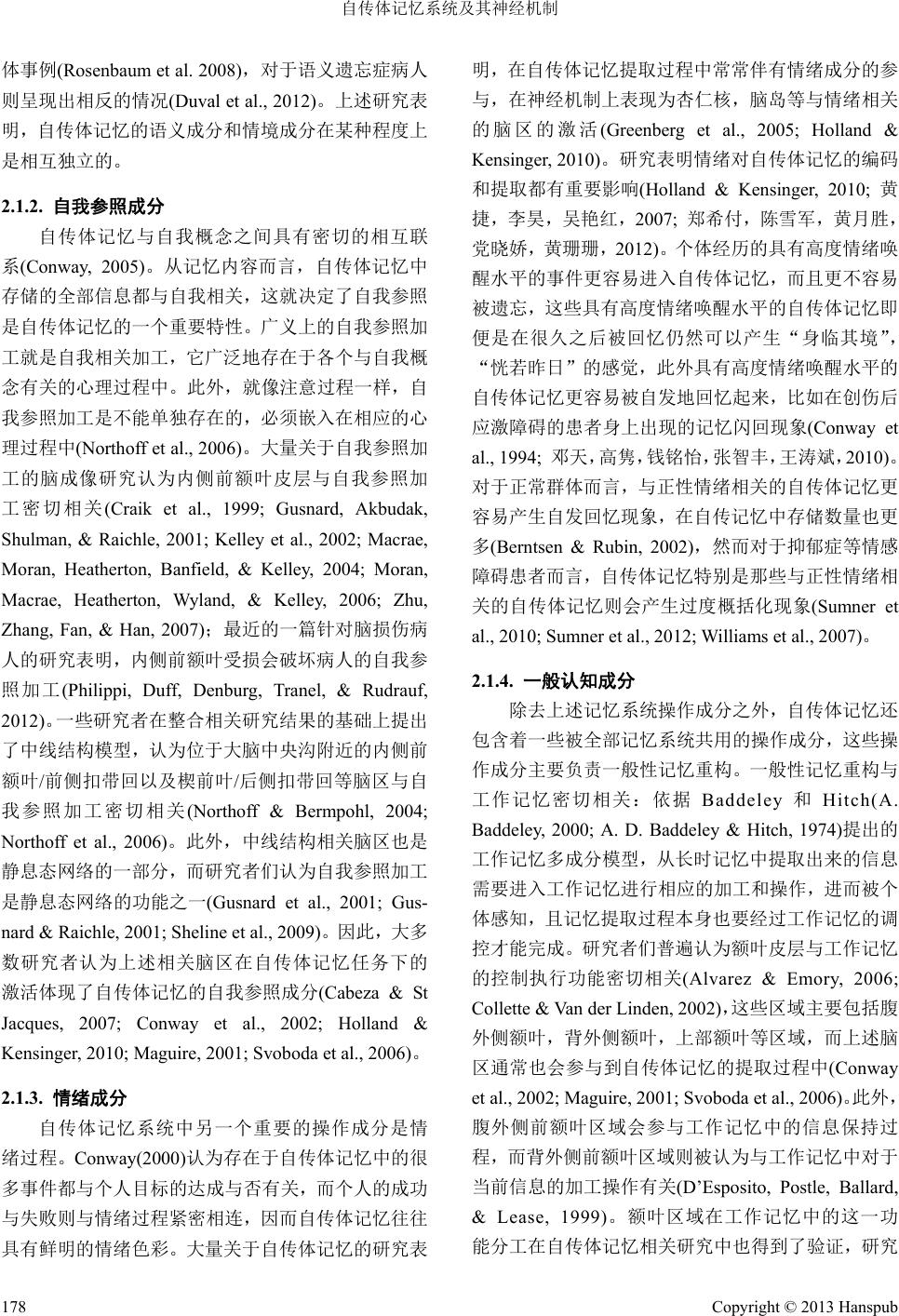 自传体记忆系统及其神经机制 体事例(Rosenbaum et al. 2008),对于语义遗忘症病人 则呈现出相反的情况(Duval et al., 2012)。上述研究表 明,自传体记忆的语义成分和情境成分在某种程度上 是相互独立的。 2.1.2. 自我参照成分 自传体记忆与自我概念之间具有密切的相互联 系(Conway, 2005)。从记忆内容而言,自传体记忆中 存储的全部信息都与自我相关,这就决定了自我参照 是自传体记忆的一个重要特性。广义上的自我参照加 工就是自我相关加工,它广泛地存在于各个与自我概 念有关的心理过程中。此外,就像注意过程一样,自 我参照加工是不能单独存在的,必须嵌入在相应的心 理过程中(Northoff et al., 2006)。大量关于自我参照加 工的脑成像研究认为内侧前额叶皮层与自我参照加 工密切相关(Craik et al., 1999; Gusnard, Akbudak, Shulman, & Raichle, 2001; Kelley et al., 2002; Macrae, Moran, Heatherton, Banfield, & Kelley, 2004; Moran, Macrae, Heatherton, Wyland, & Kelley, 2006; Zhu, Zhang, Fan, & Han, 2007);最近的一篇针对脑损伤病 人的研究表明,内侧前额叶受损会破坏病人的自我参 照加工(Philippi, Duff, Denburg, Tranel, & Rudrauf, 2012)。一些研究者在整合相关研究结果的基础上提出 了中线结构模型,认为位于大脑中央沟附近的内侧前 额叶/前侧扣带回以及楔前叶/后侧扣带回等脑区与自 我参照加工密切相关(Northoff & Bermpohl, 2004; Northoff et al., 2006)。此外,中线结构相关脑区也是 静息态网络的一部分,而研究者们认为自我参照加工 是静息态网络的功能之一(Gusnard et al., 2001; Gus- nard & Raichle, 2001; Sheline et al., 2009)。因此,大多 数研究者认为上述相关脑区在自传体记忆任务下的 激活体现了自传体记忆的自我参照成分(Cabeza & St Jacques, 2007; Conway et al., 2002; Holland & Kensinger, 2010; Maguire, 2001; Svobod a et al., 2006)。 2.1.3. 情绪成分 自传体记忆系统中另一个重要的操作成分是情 绪过程。Conway(2000)认为存在于自传体记忆中的很 多事件都与个人目标的达成与否有关,而个人的成功 与失败则与情绪过程紧密相连,因而自传体记忆往往 具有鲜明的情绪色彩。大量关于自传体记忆的研究表 明,在自传体记忆提取过程中常常伴有情绪成分的参 与,在神经机制上表现为杏仁核,脑岛等与情绪相关 的脑区的激活(Greenberg et al., 2005; Holland & Kensinger, 2010)。研究表明情绪对自传体记忆的编码 和提取都有重要影响(Holland & Kensinger, 2010; 黄 捷,李昊,吴艳红,2007; 郑希付,陈雪军,黄月胜, 党晓娇,黄珊珊,2012)。个体经历的具有高度情绪唤 醒水平的事件更容易进入自传体记忆,而且更不容易 被遗忘,这些具有高度情绪唤醒水平的自传体记忆即 便是在很久之后被回忆仍然可以产生“身临其境”, “恍若昨日”的感觉,此外具有高度情绪唤醒水平的 自传体记忆更容易被自发地回忆起来,比如在创伤后 应激障碍的患者身上出现的记忆闪回现象(Conway et al., 1994; 邓天,高隽,钱铭怡,张智丰,王涛斌,2010)。 对于正常群体而言,与正性情绪相关的自传体记忆更 容易产生自发回忆现象,在自传记忆中存储数量也更 多(Berntsen & Rubin, 2002),然而对于抑郁症等情感 障碍患者而言,自传体记忆特别是那些与正性情绪相 关的自传体记忆则会产生过度概括化现象(Sumner et al., 2010; Sumner et al., 2012; Williams et al., 2007)。 2.1.4. 一般认知成分 除去上述记忆系统操作成分之外,自传体记忆还 包含着一些被全部记忆系统共用的操作成分,这些操 作成分主要负责一般性记忆重构。一般性记忆重构与 工作记忆密切相关:依据 Baddeley 和Hitch(A. Baddeley, 2000; A. D. Baddeley & Hitch, 1974)提出的 工作记忆多成分模型,从长时记忆中提取出来的信息 需要进入工作记忆进行相应的加工和操作,进而被个 体感知,且记忆提取过程本身也要经过工作记忆的调 控才能完成。研究者们普遍认为额叶皮层与工作记忆 的控制执行功能密切相关(Alvarez & Emory, 2006; Collette & Van d er Linden, 2002),这些区域主要包括腹 外侧额叶,背外侧额叶,上部额叶等区域,而上述脑 区通常也会参与到自传体记忆的提取过程中(Conway et al., 2002; Maguire, 2001; Svoboda et al., 2006)。此外, 腹外侧前额叶区域会参与工作记忆中的信息保持过 程,而背外侧前额叶区域则被认为与工作记忆中对于 当前信息的加工操作有关(D’Esposito, Postle, Ballard, & Lease, 1999)。额叶区域在工作记忆中的这一功 能分工在自传体记忆相关研究中也得到了验证,研究 Copyright © 2013 Hanspub 178  自传体记忆系统及其神经机制 者们认为腹外侧额叶的激活保证了自传体记忆搜索 的持续性,而其他偏背侧的区域则与自传体记忆提取 信息在工作记忆中的进一步加工操作相关(Gilboa, 2004; King, Hartley, Spiers, Maguire, & Burgess, 2005)。 另有一些研究认为,与工作记忆相关的神经机制并不 局限于额叶皮层,顶叶皮层的激活也与工作记忆关系 紧密(Berryhill & Olson, 2008; Koenigs, Barbey, Postle, & Grafman, 2009),且顶叶皮层被认为参与了工作记忆 中信息更新和注意调控(Bledowski, Rahm, & Rowe, 2009)。因此,在自传体记忆提取条件下发现的顶叶区 域的激活同样在某种程度上体现了工作记忆成分的 参与。 2.2. 操作成分间的相互联系和相互作用 2.2.1. 情景成分和语义成分 自传体记忆的情境成分和语义成分与单纯的情 境记忆和语义记忆是不同的。自传体记忆具有精细的 记忆结构。Conway等人(2000)认为,自传体记忆的记 忆结构从高到低可以分为三个层次:人生时期 (lifetime period),一般事件(general event),事件具体 知识(Event-Specific Knowledge ESK)。人生时期表明 了自传体记忆发生的时间阶段,例如:童年期间,大 学时期,工作时期等;一般事件代表特定人生时期下 发生的具体事件,可以是一次性事件,如到某个地点 旅行,也可以是重复性事件,如每天傍晚出门散步; 具体事件知识是指关于一般事件的鲜活的具体细节, 经常以视觉图像或者其他感知觉细节的形式出现 (Conway et al., 1994; Freton et al., 2013)。存储于前两 个层次的自传体记忆信息侧重于对个人经历事件的 客观事实描述,因此更偏向于自传体记忆的语义成 分,而存储于第三个层次的关于个人经历事件的具体 细节则对应于自传体记忆的情境成分。自传体记忆的 语义成分和情境成分就是被上述记忆结构分层级组 织起来的。作为嵌入在自传体记忆层次结构中的情境 成分和语义成分,两者除了在特定情境下呈现出相互 独立的性质之外,在更多的情境下表现出来的则是一 种相互作用和配合。Conway 认为储存在同一段自传 体记忆不同层级间的信息具有互为线索的作用,特定 层级的信息在激活时会诱发其他层级信息的激活,进 而形成完整的自传体记忆提取。由此可见自传体记忆 的情境成分和语义成分之间在相互独立的同时还有 着密切的联系。 正是上述成分间的相互联系使得自传体记忆的 情境成分和语义成分不同于单纯的情景记忆和语义 记忆。例如针对于自传体记忆与情景记忆之间相互关 系的研究表明,虽然自传体记忆与情景记忆之间具有 大量的相似成分——诸如感知觉细节提取,自知感 (Autonoesis,指将自我投射在过去的情境中,对过去 事件进行再体验)(Lemogne et al., 2006; Piolino et al., 2006; Tulving, 2002)等,但是两者的神经机制仍然存 在差异。这一差异主要体现在额叶皮层的激活模式 上,在情景记忆提取过程中更多地会观察到右侧额叶 的激活(Tulving, Kapur, Craik, Moscovitch, & Houle, 1994),但在自传体记忆提取过程中额叶区域的激活更 多是集中在左侧皮层(Gilboa, 2004; Svoboda et al., 2006)。这一脑区激活差异可以通过成分间的相互作用 得到一定程度的解释。在自传体记忆提取过程中左侧 额叶的激活很可能同语义成分的对情境成分影响有 关。自传体记忆中的对应于具体事件知识的情境成分 是被一般事件这一语义成分所统和的,因而特定情境 成分的提取会激活相应的语义成分,而研究表明左侧 额叶与语义记忆加工相关(Binder & Desai, 2011; Vi- gneau et al., 2006)。 2.2.2. 自我参照成分和一般认知成分 虽然大量研究者认为中线结构(主要包括内侧前 额叶,前侧扣带回,楔前叶和后侧扣带回等区域)等相 关脑区在自传体记忆提取条件下的激活同自我参照 加工过程相关(Northoff & Bermpohl, 2004; Northoff et al., 2006),但是到目前为止仍然缺少直接证据将上述 脑区同自我参照加工联系在一起。而有些研究也认为 内侧前额叶,前侧扣带回,楔前叶和后侧扣带回等区 域同记忆提取密切相关(Andersen, Essick, & Siegel, 1985; Berryhill & Olson, 2008; Freton et al., 2013; Lepage, Ghaffar, Nyberg, & Tulving, 2000; Summerfield, Hassabis, & Magu ire, 2009)。造成这种争论的主要原因 是自我参照加工的特殊性——自我参照加工不能单 独存在,必须嵌入在相应的心理过程中,这就意味着 想将其单独剥离出来非常困难,而这些被嵌入的心理 过程则会带来一定程度的混淆——大量关于自我参 照效应的研究所使用的实验任务都包含一定程度的 自传体记忆提取(Craik et al., 1999; Kelley et al., 2002; Copyright © 2013 Hanspub 179 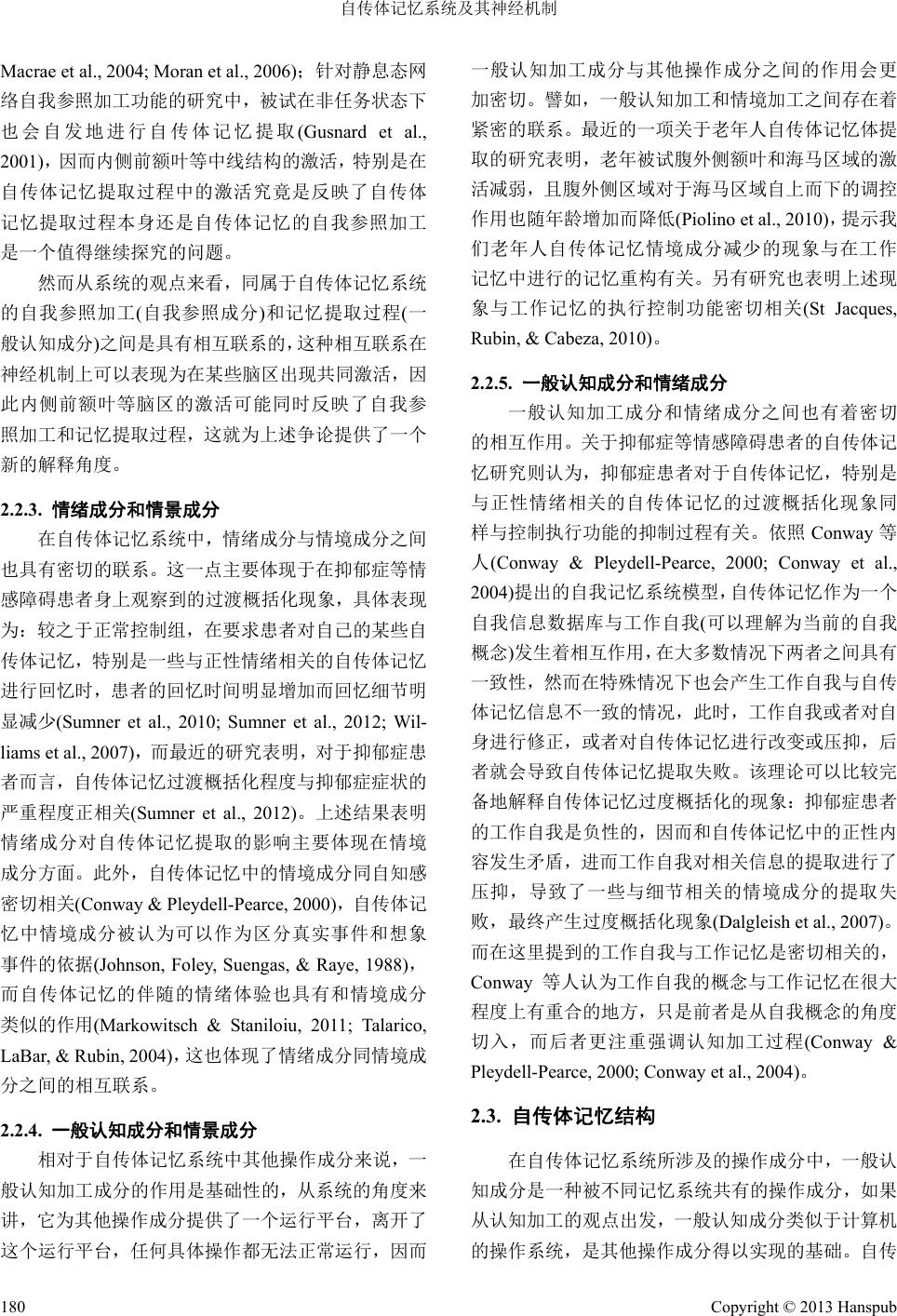 自传体记忆系统及其神经机制 Macrae et al., 2004; Moran et al., 2006);针对静息态网 络自我参照加工功能的研究中,被试在非任务状态下 也会自发地进行自传体记忆提取(Gusnard et al., 2001),因而内侧前额叶等中线结构的激活,特别是在 自传体记忆提取过程中的激活究竟是反映了自传体 记忆提取过程本身还是自传体记忆的自我参照加工 是一个值得继续探究的问题。 然而从系统的观点来看,同属于自传体记忆系统 的自我参照加工(自我参照成分)和记忆提取过程(一 般认知成分)之间是具有相互联系的,这种相互联系在 神经机制上可以表现为在某些脑区出现共同激活,因 此内侧前额叶等脑区的激活可能同时反映了自我参 照加工和记忆提取过程,这就为上述争论提供了一个 新的解释角度。 2.2.3. 情绪成分和情景成分 在自传体记忆系统中,情绪成分与情境成分之间 也具有密切的联系。这一点主要体现于在抑郁症等情 感障碍患者身上观察到的过渡概括化现象,具体表现 为:较之于正常控制组,在要求患者对自己的某些自 传体记忆,特别是一些与正性情绪相关的自传体记忆 进行回忆时,患者的回忆时间明显增加而回忆细节明 显减少(Sumner et al., 2010; Sumner et al., 2012; Wil- liams et al., 2007),而最近的研究表明,对于抑郁症患 者而言,自传体记忆过渡概括化程度与抑郁症症状的 严重程度正相关(Sumner et al., 2012)。上述结果表明 情绪成分对自传体记忆提取的影响主要体现在情境 成分方面。此外,自传体记忆中的情境成分同自知感 密切相关(Conway & Pleydell-Pearce, 2000),自传体记 忆中情境成分被认为可以作为区分真实事件和想象 事件的依据(Johnson, Foley, Suengas, & Raye, 1988), 而自传体记忆的伴随的情绪体验也具有和情境成分 类似的作用(Markowitsch & Staniloiu, 2011; Talarico, LaBar, & Rubin, 2004),这也体现了情绪成分同情境成 分之间的相互联系。 2.2.4. 一般认知成分和情景成分 相对于自传体记忆系统中其他操作成分来说,一 般认知加工成分的作用是基础性的,从系统的角度来 讲,它为其他操作成分提供了一个运行平台,离开了 这个运行平台,任何具体操作都无法正常运行,因而 一般认知加工成分与其他操作成分之间的作用会更 加密切。譬如,一般认知加工和情境加工之间存在着 紧密的联系。最近的一项关于老年人自传体记忆体提 取的研究表明,老年被试腹外侧额叶和海马区域的激 活减弱,且腹外侧区域对于海马区域自上而下的调控 作用也随年龄增加而降低(Piolino et al., 2010),提示我 们老年人自传体记忆情境成分减少的现象与在工作 记忆中进行的记忆重构有关。另有研究也表明上述现 象与工作记忆的执行控制功能密切相关(St Jacques, Rubin, & Cabeza, 2010)。 2.2.5. 一般认知成分和情绪成分 一般认知加工成分和情绪成分之间也有着密切 的相互作用。关于抑郁症等情感障碍患者的自传体记 忆研究则认为,抑郁症患者对于自传体记忆,特别是 与正性情绪相关的自传体记忆的过渡概括化现象同 样与控制执行功能的抑制过程有关。依照 Conway 等 人(Conway & Pleydell-Pearce, 2000; Conway et al., 2004)提出的自我记忆系统模型,自传体记忆作为一个 自我信息数据库与工作自我(可以理解为当前的自我 概念)发生着相互作用,在大多数情况下两者之间具有 一致性,然而在特殊情况下也会产生工作自我与自传 体记忆信息不一致的情况,此时,工作自我或者对自 身进行修正,或者对自传体记忆进行改变或压抑,后 者就会导致自传体记忆提取失败。该理论可以比较完 备地解释自传体记忆过度概括化的现象:抑郁症患者 的工作自我是负性的,因而和自传体记忆中的正性内 容发生矛盾,进而工作自我对相关信息的提取进行了 压抑,导致了一些与细节相关的情境成分的提取失 败,最终产生过度概括化现象(Dalgleish et al., 2007)。 而在这里提到的工作自我与工作记忆是密切相关的, Conway 等人认为工作自我的概念与工作记忆在很大 程度上有重合的地方,只是前者是从自我概念的角度 切入,而后者更注重强调认知加工过程(Conway & Pleydell-Pearce, 2000; Conway et al., 2004)。 2.3. 自传体记忆结构 在自传体记忆系统所涉及的操作成分中,一般认 知成分是一种被不同记忆系统共有的操作成分,如果 从认知加工的观点出发,一般认知成分类似于计算机 的操作系统,是其他操作成分得以实现的基础。自传 Copyright © 2013 Hanspub 180 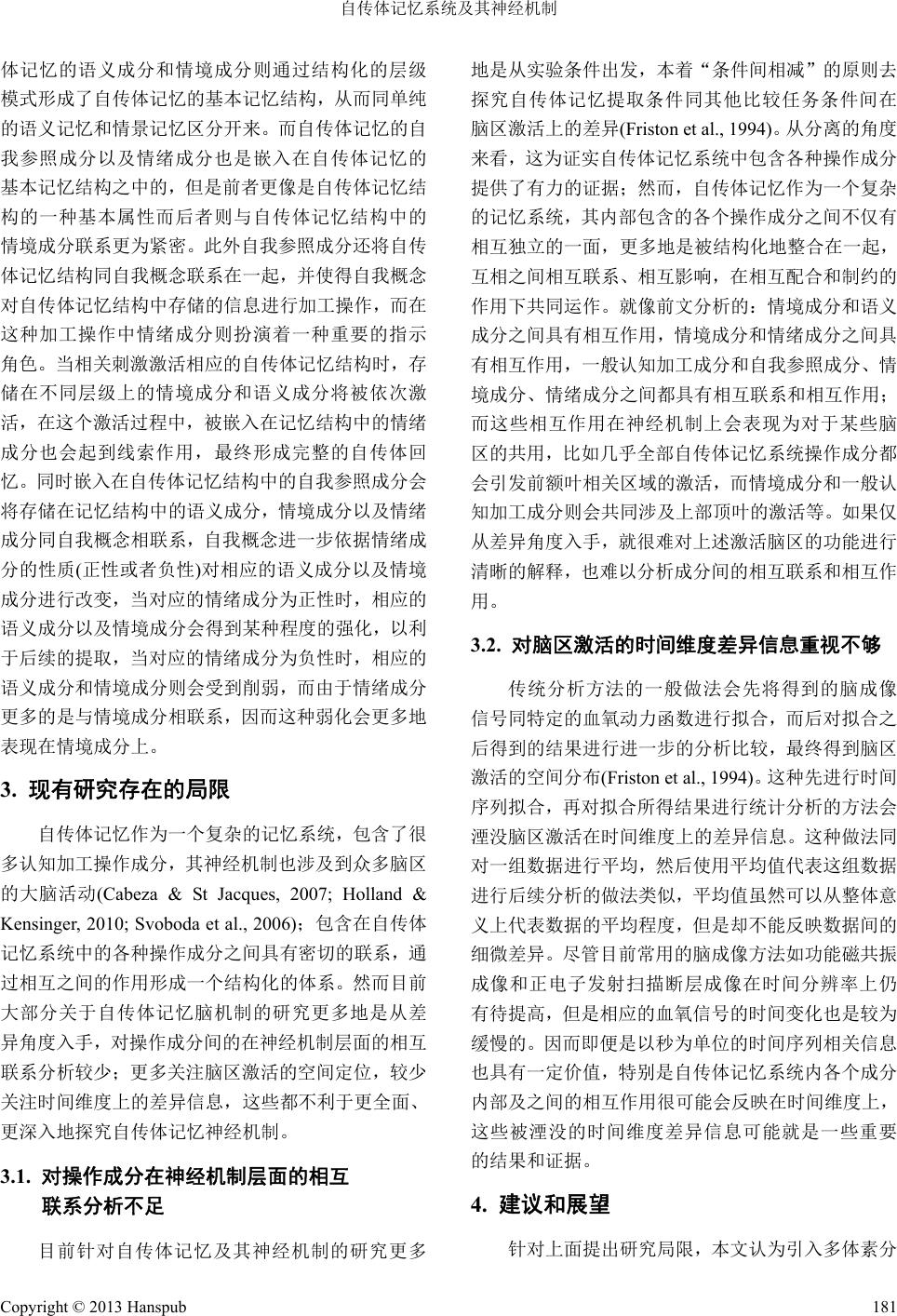 自传体记忆系统及其神经机制 体记忆的语义成分和情境成分则通过结构化的层级 模式形成了自传体记忆的基本记忆结构,从而同单纯 的语义记忆和情景记忆区分开来。而自传体记忆的自 我参照成分以及情绪成分也是嵌入在自传体记忆的 基本记忆结构之中的,但是前者更像是自传体记忆结 构的一种基本属性而后者则与自传体记忆结构中的 情境成分联系更为紧密。此外自我参照成分还将自传 体记忆结构同自我概念联系在一起,并使得自我概念 对自传体记忆结构中存储的信息进行加工操作,而在 这种加工操作中情绪成分则扮演着一种重要的指示 角色。当相关刺激激活相应的自传体记忆结构时,存 储在不同层级上的情境成分和语义成分将被依次激 活,在这个激活过程中,被嵌入在记忆结构中的情绪 成分也会起到线索作用,最终形成完整的自传体回 忆。同时嵌入在自传体记忆结构中的自我参照成分会 将存储在记忆结构中的语义成分,情境成分以及情绪 成分同自我概念相联系,自我概念进一步依据情绪成 分的性质(正性或者负性)对相应的语义成分以及情境 成分进行改变,当对应的情绪成分为正性时,相应的 语义成分以及情境成分会得到某种程度的强化,以利 于后续的提取,当对应的情绪成分为负性时,相应的 语义成分和情境成分则会受到削弱,而由于情绪成分 更多的是与情境成分相联系,因而这种弱化会更多地 表现在情境成分上。 3. 现有研究存在的局限 自传体记忆作为一个复杂的记忆系统,包含了很 多认知加工操作成分,其神经机制也涉及到众多脑区 的大脑活动(Cabeza & St Jacques, 2007; Holland & Kensinger, 2010; Svoboda et al., 2006);包含在自传体 记忆系统中的各种操作成分之间具有密切的联系,通 过相互之间的作用形成一个结构化的体系。然而目前 大部分关于自传体记忆脑机制的研究更多地是从差 异角度入手,对操作成分间的在神经机制层面的相互 联系分析较少;更多关注脑区激活的空间定位,较少 关注时间维度上的差异信息,这些都不利于更全面、 更深入地探究自传体记忆神经机制。 3.1. 对操作成分在神经机制层面的相互 联系分析不足 目前针对自传体记忆及其神经机制的研究更多 地是从实验条件出发,本着“条件间相减”的原则去 探究自传体记忆提取条件同其他比较任务条件间在 脑区激活上的差异(Friston et al., 1994)。从分离的角度 来看,这为证实自传体记忆系统中包含各种操作成分 提供了有力的证据;然而,自传体记忆作为一个复杂 的记忆系统,其内部包含的各个操作成分之间不仅有 相互独立的一面,更多地是被结构化地整合在一起, 互相之间相互联系、相互影响,在相互配合和制约的 作用下共同运作。就像前文分析的:情境成分和语义 成分之间具有相互作用,情境成分和情绪成分之间具 有相互作用,一般认知加工成分和自我参照成分、情 境成分、情绪成分之间都具有相互联系和相互作用; 而这些相互作用在神经机制上会表现为对于某些脑 区的共用,比如几乎全部自传体记忆系统操作成分都 会引发前额叶相关区域的激活,而情境成分和一般认 知加工成分则会共同涉及上部顶叶的激活等。如果仅 从差异角度入手,就很难对上述激活脑区的功能进行 清晰的解释,也难以分析成分间的相互联系和相互作 用。 3.2. 对脑区激活的时间维度差异信息重视不够 传统分析方法的一般做法会先将得到的脑成像 信号同特定的血氧动力函数进行拟合,而后对拟合之 后得到的结果进行进一步的分析比较,最终得到脑区 激活的空间分布(Friston et al., 1994)。这种先进行时间 序列拟合,再对拟合所得结果进行统计分析的方法会 湮没脑区激活在时间维度上的差异信息。这种做法同 对一组数据进行平均,然后使用平均值代表这组数据 进行后续分析的做法类似,平均值虽然可以从整体意 义上代表数据的平均程度,但是却不能反映数据间的 细微差异。尽管目前常用的脑成像方法如功能磁共振 成像和正电子发射扫描断层成像在时间分辨率上仍 有待提高,但是相应的血氧信号的时间变化也是较为 缓慢的。因而即便是以秒为单位的时间序列相关信息 也具有一定价值,特别是自传体记忆系统内各个成分 内部及之间的相互作用很可能会反映在时间维度上, 这些被湮没的时间维度差异信息可能就是一些重要 的结果和证据。 4. 建议和展望 针对上面提出研究局限,本文认为引入多体素分 Copyright © 2013 Hanspub 181 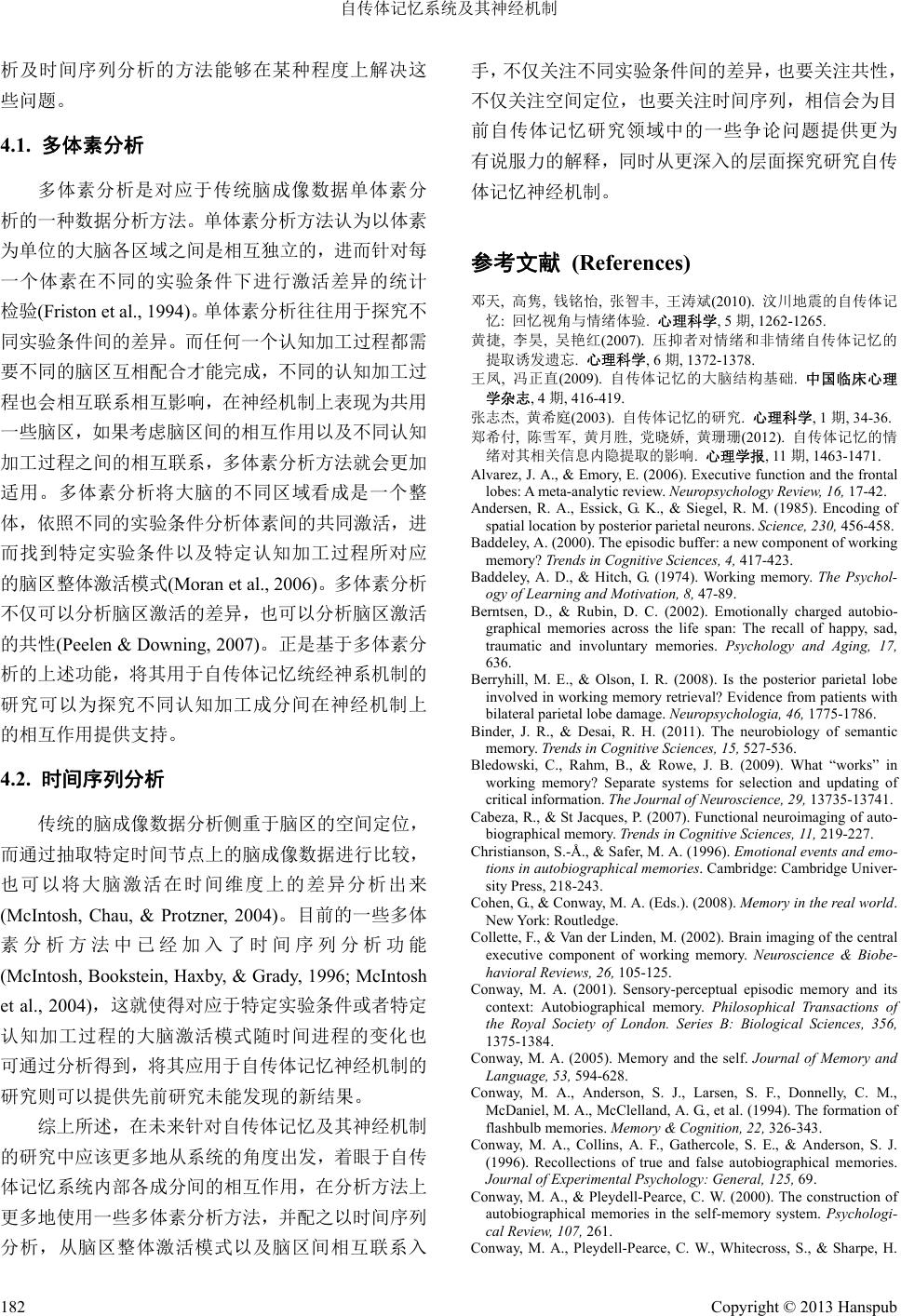 自传体记忆系统及其神经机制 析及时间序列分析的方法能够在某种程度上解决这 些问题。 4.1. 多体素分析 多体素分析是对应于传统脑成像数据单体素分 析的一种数据分析方法。单体素分析方法认为以体素 为单位的大脑各区域之间是相互独立的,进而针对每 一个体素在不同的实验条件下进行激活差异的统计 检验(Friston et al., 1994)。单体素分析往往用于探究不 同实验条件间的差异。而任何一个认知加工过程都需 要不同的脑区互相配合才能完成,不同的认知加工过 程也会相互联系相互影响,在神经机制上表现为共用 一些脑区,如果考虑脑区间的相互作用以及不同认知 加工过程之间的相互联系,多体素分析方法就会更加 适用。多体素分析将大脑的不同区域看成是一个整 体,依照不同的实验条件分析体素间的共同激活,进 而找到特定实验条件以及特定认知加工过程所对应 的脑区整体激活模式(Moran et al., 2006)。多体素分析 不仅可以分析脑区激活的差异,也可以分析脑区激活 的共性(Peelen & Downing, 2007)。正是基于多体素分 析的上述功能,将其用于自传体记忆统经神系机制的 研究可以为探究不同认知加工成分间在神经机制上 的相互作用提供支持。 4.2. 时间序列分析 传统的脑成像数据分析侧重于脑区的空间定位, 而通过抽取特定时间节点上的脑成像数据进行比较, 也可以将大脑激活在时间维度上的差异分析出来 (McIntosh, Chau, & Protzner, 2004)。目前的一些多体 素分析方法中已经加入了时间序列分析功能 (McIntosh, Bookstein, Haxby, & Grady, 1996; McIntosh et al., 2004),这就使得对应于特定实验条件或者特定 认知加工过程的大脑激活模式随时间进程的变化也 可通过分析得到,将其应用于自传体记忆神经机制的 研究则可以提供先前研究未能发现的新结果。 综上所述,在未来针对自传体记忆及其神经机制 的研究中应该更多地从系统的角度出发,着眼于自传 体记忆系统内部各成分间的相互作用,在分析方法上 更多地使用一些多体素分析方法,并配之以时间序列 分析,从脑区整体激活模式以及脑区间相互联系入 手,不仅关注不同实验条件间的差异,也要关注共性, 不仅关注空间定位,也要关注时间序列,相信会为目 前自传体记忆研究领域中的一些争论问题提供更为 有说服力的解释,同时从更深入的层面探究研究自传 体记忆神经机制。 参考文献 (References) 邓天, 高隽, 钱铭怡, 张智丰, 王涛斌(2010). 汶川地震的自传体记 忆: 回忆视角与情绪体验. 心理科学, 5期, 1262-1265. 黄捷, 李昊, 吴艳红(2007). 压抑者对情绪和非情绪自传体记忆的 提取诱发遗忘. 心理科学, 6期, 1372-1378. 王凤, 冯正直(2009). 自传体记忆的大脑结构基础. 中国临床心理 学杂志, 4期, 416-419. 张志杰, 黄希庭(2003). 自传体记忆的研究. 心理科学, 1期, 34-36. 郑希付, 陈雪军, 黄月胜, 党晓娇, 黄珊珊(2012). 自传体记忆的情 绪对其相关信息内隐提取的影响. 心理学报, 11期, 1463-1471. Alvarez, J. A., & Emory, E. (2006). Executive function and the frontal lobes: A meta-analytic review. Neuropsychology Revi e w, 16, 17-42. Andersen, R. A., Essick, G. K., & Siegel, R. M. (1985). Encoding of spatial location by posterior parietal neurons. Science, 230, 456-458. Baddeley, A. (2000). The episodic buffer : a new component of working memory? Trends in Cognitive Sciences, 4, 417-423. Baddeley, A. D., & Hitch, G. (1974). Working memory. The Psychol- ogy of Learning and Motivation , 8, 47-89. Berntsen, D., & Rubin, D. C. (2002). Emotionally charged autobio- graphical memories across the life span: The recall of happy, sad, traumatic and involuntary memories. Psychology and Aging, 17, 636. Berryhill, M. E., & Olson, I. R. (2008). Is the posterior parietal lobe involved in working memory retrieval? Evidence from patients with bilateral parietal lobe damage. Neuropsychologia, 46, 1775-1786. Binder, J. R., & Desai, R. H. (2011). The neurobiology of semantic memory . Trends in Cognitive Sciences, 15, 527-536. Bledowski, C., Rahm, B., & Rowe, J. B. (2009). What “works” in working memory? Separate systems for selection and updating of critical information. The Journal of Neuroscience, 29 , 13735-13741. Cabeza, R., & St Jacques, P. (2007). Functional neuroimaging of auto- biographical memory. Trends in Cognitive Sciences, 11, 219-227. Christianson, S.-Å., & Safer, M. A. (1996). Emotional events and emo- tions in autobiographical memories. Cambridge: Cambridge Univer- sity Press, 218-243. Cohen, G., & Conway, M. A. (Eds.). (2008). Memory in the real world. New York: Routledge. Collette, F., & Van der Linden, M. (2002). Brain imaging of the central executive component of working memory. Neuroscience & Biobe- havioral Reviews, 26, 105-125. Conway, M. A. (2001). Sensory-perceptual episodic memory and its context: Autobiographical memory. Philosophical Transactions of the Royal Society of London. Series B: Biological Sciences, 356, 1375-1384. Conway, M. A. (2005). Memory and the self. Journal of Memory and Language, 53, 594-628. Conway, M. A., Anderson, S. J., Larsen, S. F., Donnelly, C. M., McDaniel, M. A., McClelland, A. G., et al. (1994). The formation of flashbulb memories. Memory & Cognition, 22, 326-343. Conway, M. A., Collins, A. F., Gathercole, S. E., & Anderson, S. J. (1996). Recollections of true and false autobiographical memories. Journal of Experimental Psychology: Genera l, 125, 69. Conway, M. A., & Pleydell-Pearce, C. W. (2000). The construction of autobiographical memories in the self-memory system. Psychologi- cal Review, 107, 261. Conway, M. A., Pleydell-Pearce, C. W., Whitecross, S., & Sharpe, H. Copyright © 2013 Hanspub 182 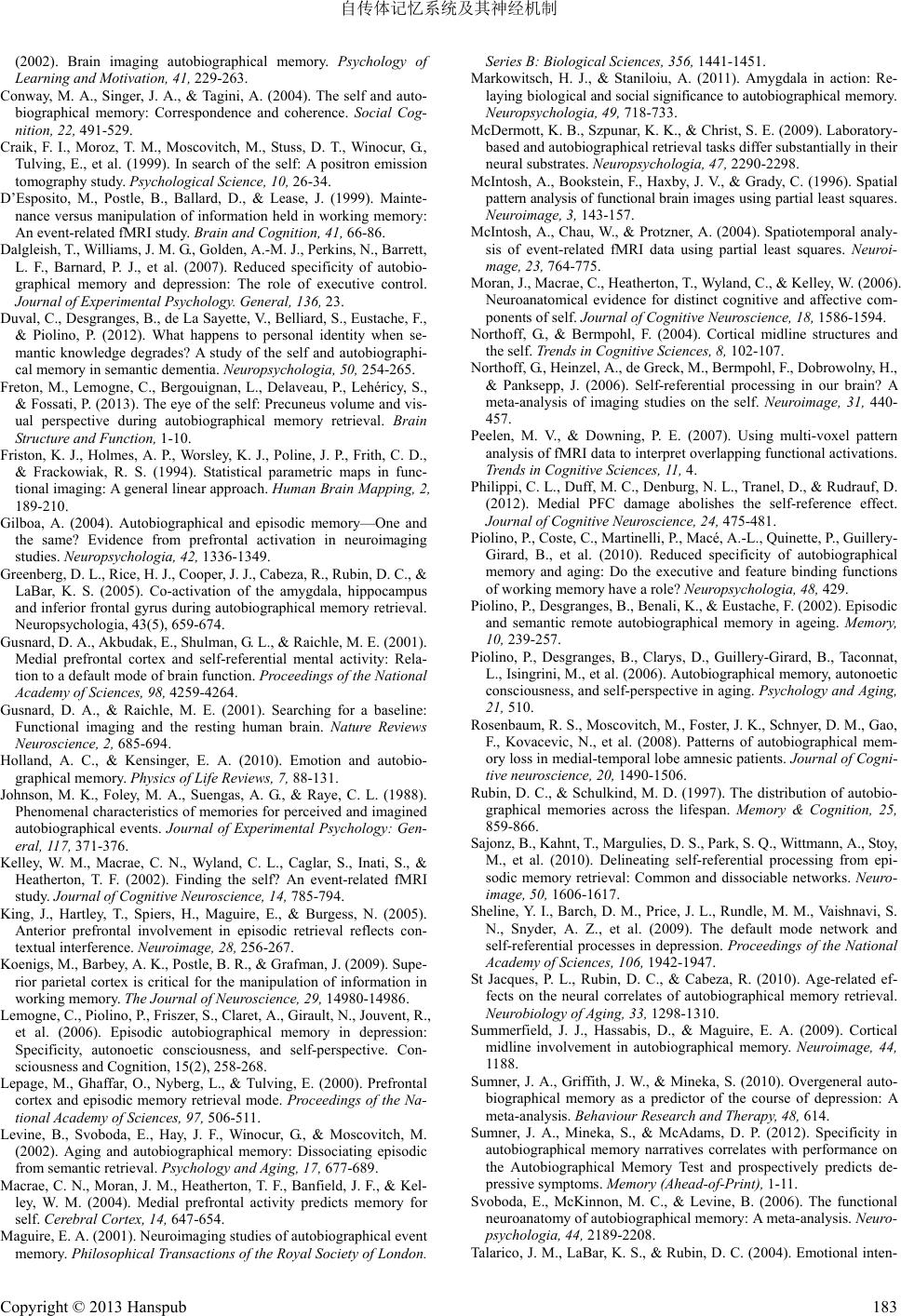 自传体记忆系统及其神经机制 (2002). Brain imaging autobiographical memory. Psychology of Learning and Motivation, 4 1, 229-263. Conway, M. A., Singer, J. A., & Tagini, A. (2004). The self and auto- biographical memory: Correspondence and coherence. Social Cog- nition, 22, 491-529. Craik, F. I., Moroz, T. M., Moscovitch, M., Stuss, D. T., Winocur, G., Tulving, E., et al. (1999). In search of the self: A positron emission tomography study. Psychological Science, 10, 26-34. D’Esposito, M., Postle, B., Ballard, D., & Lease, J. (1999). Mainte- nance versus manipulation of information held in working memory: An event-related fMRI study. Brain and Cognition, 41, 66-86. Dalgleish, T., Willi ams, J. M. G., Golden, A.-M. J., Perkins, N., Barrett, L. F., Barnard, P. J., et al. (2007). Reduced specificity of autobio- graphical memory and depression: The role of executive control. Journal of Experimental Psychology. General, 136, 23. Duval, C., Desgranges, B., de La Sayette, V., Belliard, S., Eustache, F., & Piolino, P. (2012). What happens to personal identity when se- mantic knowledge degrades? A study of the self and autobiographi- cal memory in semantic dementia. Neuro ps ychologia, 50, 254-265. Freton, M., Lemogne, C., Bergouignan, L., Delaveau, P., Lehéricy, S., & Fossati, P. (2013). The eye of the self: Precuneus volume and vis- ual perspective during autobiographical memory retrieval. Brain Structure and Fun ction, 1-10. Friston, K. J., Holmes, A. P., Worsley, K. J., Poline, J. P., Frith, C. D., & Frackowiak, R. S. (1994). Statistical parametric maps in func- tional imaging: A general linear approach. Human Brain Mapping, 2, 189-210. Gilboa, A. (2004). Autobiographical and episodic memory—One and the same? Evidence from prefrontal activation in neuroimaging studies. Neuropsychologia, 42, 1336-1349. Greenberg, D. L., Rice, H. J., Cooper, J. J., Cabeza, R., Rubin, D. C., & LaBar, K. S. (2005). Co-activation of the amygdala, hippocampus and inferior frontal gyrus during autobiographical memory retrieval. Neuropsychologia, 43(5) , 659-674. Gusnard, D. A., Akbudak, E., Shulman, G. L., & Raichle, M. E. (2001). Medial prefrontal cortex and self-referential mental activity: Rela- tion to a default mode of brain function. Proceedings of the National Academy of Sciences, 98, 4259-4264. Gusnard, D. A., & Raichle, M. E. (2001). Searching for a baseline: Functional imaging and the resting human brain. Nature Reviews Neuroscience, 2, 685-694. Holland, A. C., & Kensinger, E. A. (2010). Emotion and autobio- graphical memory. Physics of Life Reviews, 7, 88-131. Johnson, M. K., Foley, M. A., Suengas, A. G., & Raye, C. L. (1988). Phenomenal characteristics of memories for perceived and imagined autobiographical events. Journal of Experimental Psychology: Gen- eral, 117, 371-376. Kelley, W. M., Macrae, C. N., Wyland, C. L., Caglar, S., Inati, S., & Heatherton, T. F. (2002). Finding the self? An event-related fMRI study. Journal of Cognitive Neuroscience, 14, 785-794. King, J., Hartley, T., Spiers, H., Maguire, E., & Burgess, N. (2005). Anterior prefrontal involvement in episodic retrieval reflects con- textual interference. Neuroimage, 28, 256-267. Koenigs, M., Barbey, A. K., Postle, B. R., & Grafman, J. (2009). Supe- rior parietal cortex is critical for the manipulation of information in wor king memo ry. The Journa l of Neuroscience, 29, 14980-14986. Lemogne, C., Piolino, P., Friszer, S., Claret, A., Girault, N., Jouvent, R., et al. (2006). Episodic autobiographical memory in depression: Specificity, autonoetic consciousness, and self-perspective. Con- sciousness and Cognition, 15(2), 258-268. Lepage, M., Ghaffar, O., Nyberg, L., & Tulving, E. (2000). Prefrontal cortex and episodic memory retrieval mode. Proceedings of the Na- tional Academy of Sciences, 97, 506-511. Levine, B., Svoboda, E., Hay, J. F., Winocur, G., & Moscovitch, M. (2002). Aging and autobiographical memory: Dissociating episodic from semantic retrieval. Psychology and Aging, 17, 677-689. Macrae, C. N., Mo ran, J. M., Heatherton, T. F., Ban field, J. F., & Kel- ley, W. M. (2004). Medial prefrontal activity predicts memory for self. Cerebral Cortex, 14, 647-654. Maguire, E. A. (2001). Neuroimaging studies of autobiographical event memory . Philosophical Transactions of the Royal Society of London. Series B: Biological Sciences, 356, 1441-1451. Markowitsch, H. J., & Staniloiu, A. (2011). Amygdala in action: Re- lay in g bi ol og ic al and social significance to autobiog raphica l me mo ry. Neuropsychologia, 49 , 718-733. McDermott, K. B., Szpunar, K. K., & Christ, S. E. (2009). Laboratory- based and autobiograph i c al retrieval tasks d i ffer substantially in their neural substrates. Neuropsychologia, 47, 2290-2298. McIntosh, A., Bookstein, F., Haxby, J. V., & Grady, C. (1996). Spatial pattern analysis of functional brain images using partial least squares. Neuroimage, 3, 143-157. McIntosh, A., Chau, W., & Protzner, A. (2004). Spatiotemporal analy- sis of event-related fMRI data using partial least squares. Neuroi- mage, 23, 764-775. Moran, J., Macrae, C., Heatherton, T., Wyland, C., & Kelley, W. (2006). Neuroanatomical evidence for distinct cognitive and affective com- ponents of self. Journal of Cognitive Neuroscience, 18, 1586-1594. Northoff, G., & Bermpohl, F. (2004). Cortical midline structures and the self. Trends in Cognitive Sciences, 8, 102-107. Northoff, G., Heinzel, A., de Greck, M., Bermpohl, F., Dobrowolny, H., & Panksepp, J. (2006). Self-referential processing in our brain? A meta-analysis of imaging studies on the self. Neuroimage, 31, 440- 457. Peelen, M. V., & Downing, P. E. (2007). Using multi-voxel pattern analysis of fMRI data to interpret overlapping functional activations. Trend s in Cognitive Sciences, 11, 4. Philippi, C. L., Duff, M. C., Denburg, N. L., Tranel, D., & Rudrauf, D. (2012). Medial PFC damage abolishes the self-reference effect. Journal of Cognitive Neuroscience, 24, 475-481. Piolino, P., Cos te, C., Martinelli, P., Macé, A.-L., Quinette, P., Guillery- Girard, B., et al. (2010). Reduced specificity of autobiographical memory and aging: Do the executive and feature binding functions of working memory have a role? Neuropsychologia, 48, 429. Piolino, P., Desgranges, B., Benali, K., & Eustache, F. (2002). Episodic and semantic remote autobiographical memory in ageing. Memory, 10, 239-257. Piolino, P., Desgranges, B., Clarys, D., Guillery-Girard, B., Taconnat, L., Isingrini, M., et al. (2006). Autobiographical memory, autonoetic consciousness, and self-perspective in aging. Psychology and Aging, 21, 510. Rosenbaum, R. S., Mosco vitch, M., Foster, J. K., Schnyer, D. M., Gao, F., Kovacevic, N., et al. (2008). Patterns of autobiographical mem- ory loss in medial-temporal lobe amnesic patients. Journal of Cogni- tive neuroscience, 20, 1490-1506. Rubin, D. C., & Schulkind, M. D. (1997). The distribution of autobio- graphical memories across the lifespan. Memory & Cognition, 25, 859-866. Sajonz, B., Kahnt, T., Margulies, D. S., Park, S. Q., Wittmann, A., Stoy, M., et al. (2010). Delineating self-referential processing from epi- sodic memory retrieval: Common and dissociable networks. Neuro- image, 50, 1606-1617. Sheline, Y. I., Barch, D. M., Price, J. L., Rundle, M. M., Vaishnavi, S. N., Snyder, A. Z., et al. (2009). The default mode network and self-referential processes in depression. Proceedings of the National Academy of Sciences, 106, 1942-1947. St Jacques, P. L., Rubin, D. C., & Cabeza, R. (2010). Age-related ef- fects on the neural correlates of autobiographical memory retrieval. Neurobiology of Aging, 33, 1298-1310. Summerfield, J. J., Hassabis, D., & Maguire, E. A. (2009). Cortical midline involvement in autobiographical memory. Neuroimage, 44, 1188. Sumner, J. A., Griffith, J. W., & Mineka, S. (2010). Overgeneral auto- biographical memory as a predictor of the course of depression: A meta-analysis. Behaviour Research and Therapy, 48, 614. Sumner, J. A., Mineka, S., & McAdams, D. P. (2012). Specificity in autobiographical memory narratives correlates with performance on the Autobiographical Memory Test and prospectively predicts de- pressive symptoms. Memory (Ahead-of-Print), 1-11. Svoboda, E., McKinnon, M. C., & Levine, B. (2006). The functional neuroanatomy of autobiographical memory: A meta-analysis. Neuro- psychologia, 44, 2189-2208. Talarico, J. M., LaBar, K. S., & Rubin, D. C. (2004). Emotional inten- Copyright © 2013 Hanspub 183  自传体记忆系统及其神经机制 Copyright © 2013 Hanspub 184 sity predicts autobiographical memory experience. Memory & Cog- nition, 32, 1118-1132. Tulving, E. (1972). Episodic and semantic memory. Organization of Memory, 1, 381-402. Tulving, E. (1985). How many memory systems are there. American Psychologist, 40, 385-398. Tulving, E. (2002). Episodic memory: From mind to brain. Annual Review of Psychology, 53, 1-25. Tulving, E., Kapur, S., Craik, F., Moscovitch, M., & Houle, S. (1994). Hemispheric encoding/retrieval asymmetry in episodic memory: Positron emission tomography findings. Proceedings of the National Academy of Sciences, 91, 2016-2020. Vigneau, M., Beaucousin, V., Herv , P., Duffau, H., Crivello, F., Houd, O., et al. (2006). Meta-analyzing left hemisphere language areas: Phonology, semantics, and sentence processing. Neuroimage, 30, 1414-1432. Williams, J. M. G., Barnhofer, T., Crane, C., Herman, D., Raes, F., Watkins, E., et al. (2007). Autobiographical memory specificity and emotional disorder. Psychological Bulletin, 133, 122. Zhu, Y., Zhang, L., Fan, J., & Han, S. (2007). Neural basis of cultural influence on self-representation. Neuroimage, 34, 1310-1316. |